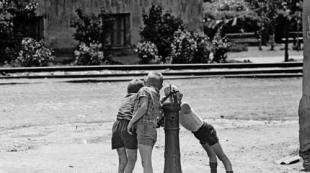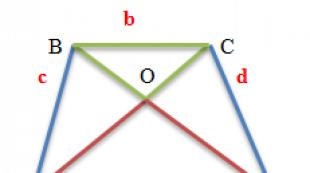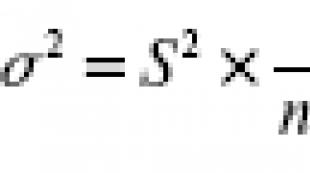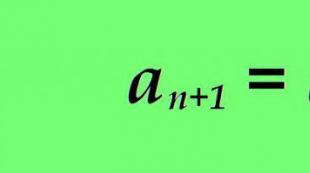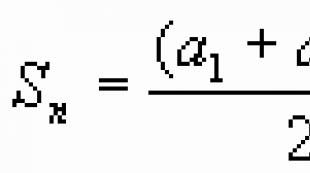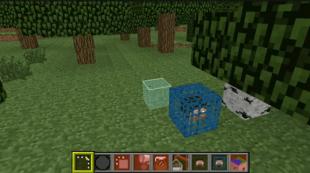The native properties of a protein are determined by its structure. Tertiary structure. Theoretical foundations of the lesson
The existence of 4 levels of the structural organization of the protein molecule has been proven.
Primary protein structure- the sequence of the location of amino acid residues in the polypeptide chain. In proteins, individual amino acids are linked to each other peptide bonds arising from the interaction of a-carboxyl and a-amino groups of amino acids.
By now, the primary structure of tens of thousands of different proteins has been deciphered. To determine the primary structure of the protein, the amino acid composition is determined by hydrolysis methods. Then the chemical nature of the terminal amino acids is determined. The next step is to determine the amino acid sequence in the polypeptide chain. For this, selective partial (chemical and enzymatic) hydrolysis is used. It is possible to use X-ray structural analysis, as well as data on the complementary nucleotide sequence of DNA.
Secondary protein structure- the configuration of the polypeptide chain, i.e. a method of packaging a polypeptide chain into a specific conformation. This process does not proceed chaotically, but in accordance with the program laid down in the primary structure.
The stability of the secondary structure is provided mainly by hydrogen bonds, however, a certain contribution is made by covalent bonds - peptide and disulfide.
The most probable type of structure of globular proteins is considered a-helix... The twisting of the polypeptide chain occurs clockwise. Each protein is characterized by a certain degree of spiralization. If hemoglobin chains are spiralized by 75%, then pepsin is only 30%.
The type of configuration of polypeptide chains found in proteins of hair, silk, muscles is called b-structures... Segments of the peptide chain are arranged in one layer, forming a figure similar to a folded leaf in an accordion. The layer can be formed by two or big amount peptide chains.
In nature, there are proteins whose structure does not correspond to either the β- or a-structure, for example, collagen, a fibrillar protein that makes up the bulk of the connective tissue in humans and animals.
Protein tertiary structure- the spatial orientation of the polypeptide helix or the method of folding the polypeptide chain in a certain volume. The first protein, the tertiary structure of which was elucidated by X-ray diffraction analysis, is sperm whale myoglobin (Fig. 2).
In the stabilization of the spatial structure of proteins, in addition to covalent bonds, the main role is played by non-covalent bonds (hydrogen, electrostatic interactions of charged groups, intermolecular van der Waals forces, hydrophobic interactions, etc.).
According to modern concepts, the tertiary structure of a protein, after the completion of its synthesis, is formed spontaneously. Basic driving force is the interaction of amino acid radicals with water molecules. In this case, non-polar hydrophobic amino acid radicals are immersed inside the protein molecule, and polar radicals are oriented towards water. The process of formation of the native spatial structure of the polypeptide chain is called folding... Proteins are isolated from the cells, called chaperones. They participate in folding. A number of hereditary human diseases are described, the development of which is associated with a violation due to mutations in the folding process (pigmentosis, fibrosis, etc.).
The existence of levels of the structural organization of the protein molecule, intermediate between the secondary and tertiary structures, has been proved by the methods of X-ray diffraction analysis. Domain is a compact globular structural unit inside the polypeptide chain (Fig. 3). Many proteins (for example, immunoglobulins) have been discovered that consist of domains of different structure and function, encoded by different genes.
All biological properties of proteins are associated with the preservation of their tertiary structure, which is called native... A protein globule is not an absolutely rigid structure: reversible movements of parts of the peptide chain are possible. These changes do not violate the overall conformation of the molecule. The conformation of a protein molecule is influenced by the pH of the medium, the ionic strength of the solution, and interaction with other substances. Any effects leading to a violation of the native conformation of the molecule are accompanied by a partial or complete loss of the protein's biological properties.
Quaternary protein structure- a method of laying in space of individual polypeptide chains having the same or different primary, secondary or tertiary structure, and the formation of a single macromolecular formation in structural and functional terms.
A protein molecule consisting of several polypeptide chains is called oligomer, and each chain included in it - protometer... Oligomeric proteins are often built from an even number of protomers, for example, a hemoglobin molecule consists of two a- and two b-polypeptide chains (Fig. 4).
About 5% of proteins, including hemoglobin and immunoglobulins, have a quaternary structure. The subunit structure is characteristic of many enzymes.
Protein molecules that make up a protein with a quaternary structure are formed on ribosomes separately and only after the end of synthesis form a common supramolecular structure. Protein acquires biological activity only when its constituent protomers combine. The same types of interactions are involved in the stabilization of the quaternary structure as in the stabilization of the tertiary.
Some researchers acknowledge the existence of a fifth level of structural organization of proteins. it metabolones - polyfunctional macromolecular complexes of various enzymes that catalyze the entire path of substrate transformations (higher fatty acid synthetases, pyruvate dehydrogenase complex, respiratory chain).
The peptide bond defines the backbone (ridge) of the primary structure of the protein molecule and gives it rigidity.
Theoretical foundations of the lesson
Protein molecule structure
The purpose of the lesson: to study the types of macromolecular organization of protein molecules.
Primary structure of proteins- the sequence of amino acids in the polypeptide chain (or chains) and the position of disulfide bonds (if any).
The primary structure is stabilized by covalent bonds: peptide, and in some peptides and disulfide.
The destruction of covalent bonds of the primary structure - hydrolysis: 1) acidic - in 6 N. HCl, 100-110 0 С, 24 hours; 2) enzymatic - with the help of proteolytic enzymes in the stomach at pH 1.5-5.0 - pepsin; trypsin, chymotrypsin, carboxypeptidases - in the duodenum; dipeptidases, tripeptidases and aminopeptidases - in the small intestine, at a pH of 8.6.
Characterization of the peptide bond... The peptide bond is flat (coplanar). C-N bond resembles a double bond (rotation is impossible) due to p, π - conjugation (conjugation of a free pair of electrons of an atom with π-electrons of a double bond C = O).
The sequence of amino acids in the primary structure of the protein is specific species characteristics of this protein.
Protein primary structure genetically determined and reproduced in the processes of transcription and translation.
The primary structure of the protein is basic for the formation of subsequent protein structures due to the interaction of radicals of amino acid residues of the polypeptide chain.
Replacing an L-series amino acid with a D-series amino acid or replacing even one L-amino acid with another can lead to complete disappearance biological activity peptide.
Physiologically active peptides contain from 3 to 100 amino acid residues (MW below 6000 Da). Unlike proteins, polypeptides may contain non-proteinogenic or modified proteinogenic amino acids. Examples:
1. Bradykinin and kallidin cause relaxation of smooth muscles and are products of proteolysis of specific a 2 -globulins in plasma, therefore these peptides contain only proteinogenic amino acids:
bradykinin: arg-pro-pro-gly-phen-ser-pro-phen-arg;
kallidin: Liz-arg-pro-pro-gli-fen-ser-pro-fen-arg.
2. Glutathione (γ-glu-cis-gly) is found in all cells. It is necessary for the transport of amino acids across membranes, for the work of a number of enzymes. Retains disulfide bonds, contains an atypical peptide bond when glutamate is linked to cysteine not through the α-amino group.
Protein polymorphism- this is the existence of the same protein in several molecular forms that differ in primary structure, physical chemical properties and manifestations of biological activity.
The causes of protein polymorphism are gene recombinations and mutations. Isoproteins are multiple molecular forms of a protein found within organisms of the same biological species as a result of the presence of more than one structural gene in the gene pool of a species. Multiple genes can be represented as multiple alleles or multiple gene loci.
Examples of protein polymorphism.
1. Protein polymorphism in phylogenesis - the existence of homologous proteins in different species. In these proteins, the regions of the primary structure that are responsible for their function remain conserved (unchanged). To replace the lost proteins in the human body, homologous proteins of animals are used, in the primary structure of which there are minimal differences (insulin from bovine, pig, sperm whale).
2. Polymorphism of proteins in ontogenesis - the existence of homologous proteins in different parts of the life cycle of an organism. The fetus has hemoglobin F (fetal hemoglobin, α 2 γ 2, has a high affinity for oxygen). After birth, it is replaced by hemoglobin A1 (a 2 b 2).
3. Tissue polymorphism of proteins. The same enzyme in different cells catalyzes the same reaction, but has differences in the primary structure - isozymes. Determination of isoenzymes in the blood helps to diagnose damage to a specific tissue.
4. Protein polymorphism in pathology. Consider the example of multiple forms of inherited mutations. In this case, the replacement of an acidic amino acid with a basic or neutral one occurs most often:
in HbC, replacement of glu 6 in the β-chain with lysis;
in HbE, the replacement of Glu 26 in the β-chain by lysis;
in HbI, replacement of lys 16 in the β-chain with asp;
in HbS, the replacement of glo 6 in the β-chain by a shaft.
In the latter case, a disease such as sickle cell anemia occurs. Abnormal hemoglobins differ from normal in the amount of charge and electrophoretic mobility. Physicochemical changes in hemoglobins are accompanied by impaired oxygen transport.
Secondary protein structure- regular organization of the polypeptide chain, stabilized by hydrogen bonds. Hydrogen bonds are formed between NH and CO groups of peptide bonds. Distinguish between a-helix, b-structure and disordered conformation (coil).
a-Spiral. The twisting of the polypeptide chain is clockwise (right-handed spiral), which is due to the structure of L-amino acids. There are 3.6 amino acid residues for each turn (step) of the helix. The helix pitch is 0.54 nm, with 0.15 nm per amino acid residue. The ascent angle of the spiral is 26 0. every 5 turns of the helix (18 amino acid residues), the structure of the polypeptide chain is repeated. Hydrogen bonds are parallel to the helix axis and arise between every first and every fifth amino acid residue. The formation of a-helix is prevented by proline and amino acids with bulky and charged radicals.
Β-Structure. In fibrillar proteins, two or more linear polypeptide chains are tightly bound by hydrogen bonds perpendicular to the axis of the molecule (folded b-layer). If two polypeptide chains running in the same direction from the N- to the C-terminus are connected by interchain hydrogen bonds, then this is a parallel β-structure. If the N- and C-ends of the chains are opposite, then this is an antiparallel b-structure. If one polypeptide chain bends and runs parallel to itself, then this is an antiparallel β-cross-structure. Bending points of the chain are determined by pro, gli, asn-b-bend.
Disordered conformation. Areas of a protein molecule that do not belong to helical or folded structures are called disordered. In a graphic representation, spiral sections are depicted as a cylinder, and folded structures - with an arrow. The concept of a supra-secondary structure is distinguished, which is a regular alternation of a-helical sections and b-structures.
Tertiary structure- the conformation of the polypeptide chain as a whole (i.e., location in three-dimensional space). The tertiary structure is stabilized by bonds and interactions between the radicals of amino acid residues of the polypeptide chain: covalent - disulfide bonds, as well as hydrogen, ionic bonds and hydrophobic interactions. Types of proteins with a tertiary structure:
proteins, which are dominated by a-helical regions, have the form of globules (globular proteins) and perform dynamic functions;
proteins, in which the structures of the folded b-layer prevail, have a filamentous (fibillary proteins) shape and perform structural functions;
collagen is the most abundant protein in the animal world (up to 25% of all body proteins), has a special structure. The collagen (tropocollagen) molecule is built of three polypeptide chains. Each polypeptide chain contains about 1000 amino acid residues (35% glycine, 21% proline and hydroxyproline, 11% alanine). Each polypeptide chain has a tight helix conformation (3 amino acid residues per turn). In the tropocollagen molecule, all three helices are intertwined with each other, forming a bundle. Hydrogen bonds are formed between the helices due to peptide groups. This structure provides the strength of the collagen fibers.
Native protein structure.
Many proteins in the tertiary structure have coiled, folded, and disordered segments. At the same time, in functional and structural terms, it is important mutual arrangement amino acid radicals. The following terms are used:
domains – anatomically distinguished areas of the tertiary structure of a protein responsible for the performance of a specific function of the protein;
hydrophobic pockets – cavities in the tertiary structure, lined with radicals of hydrophobic amino acids; serve to immerse hydrophobic ligands in a protein molecule;
hydrophobic clusters – areas of the protein surface where radicals of hydrophobic amino acids are concentrated; serve to interact with hydrophobic clusters of other molecules.
To perform a function, a protein must have a specific and often only tertiary structure (conformation) - a native structure.
It is caused by the interaction of amino acid residues that are far apart from each other in a linear sequence. Maintenance factors:
hydrogen bonds
hydrophobic interactions (needed for the structure and biological functions of the protein)
disulfide and salt bridges
ionic and van der Waals bonds.
In most proteins, the surface of the molecules contains residues of amino acid radicals with hydrophilic properties. HC - radicals that are hydrophobic and located inside the molecules. This distribution is important in the formation of the native structure and properties of the protein.
As a result, proteins have a hydration shell, and the stabilization of the tertiary structure is largely due to hydrophobic interactions. For example, 25-30% of amino acid residues in globulin molecules have pronounced hydrophobic radicals, 45-50% contain ionic and polar radical groups.
The side chains of amino acid residues that are responsible for the structure of proteins are distinguished by size, shape, charge and ability to form hydrogen bonds, as well as by chemical reactivity:
aliphatic side chains such as valine, alanine. It is these residues that form hydrophobic interactions.
hydroxylated aliphatic (series, threonine). These amino acid residues are involved in the formation of hydrogen bonds, as well as esters, for example, with sulfuric acid.
aromatic - these are the remains of phenylalanine, tyrosine, tryptophan.
amino acid residues with basic properties (lysine, arginine, histidine). The predominance of such amino acids in the polypeptide chain gives proteins basic properties.
residues with acidic properties (aspartic and glutamic acids)
amide (asparagine, glutamine)
Proteins containing several polypeptide chains have a quaternary structure. This refers to the way the chains are laid relative to each other. These enzymes are called subunits. Currently, it is customary to use the term "domain", which denotes a compact globular unit of a protein molecule. Many proteins are composed of several such units with a mass of 10 to 20 kDa. In proteins of high molecular weight, individual domains are connected by relatively flexible regions of the PCP. In the body of animals and humans, there are even more complex structural organizations of proteins, an example of which can be multienzyme systems, in particular, the pyruvate decarboxylase complex.
The concept of native protein
At certain pH and temperature values, the PCP has, as a rule, only one conformation, which is called native and in which the protein in the body performs its specific function. Almost always, this single conformation predominates energetically over tens and hundreds of variants of other conformations.
Classification. Biological and chemical properties of proteins
There is no satisfactory classification of proteins, they are conventionally classified according to their spatial structure, solubility, biological functions, physicochemical properties and other characteristics.
1.In terms of the structure and shape of molecules, proteins are subdivided into:
globular (spherical)
fibrillar (filamentous)
2.the chemical composition is divided into:
Simple ones that consist only of amino acid residues
Complex, have non-protein compounds in their molecules. The classification of complex proteins is based on the chemical nature of the non-protein components.
One of the main types of classification:
Z. according to the biological functions performed:
Enzymatic catalysis. In biological systems, all chemical reactions are catalyzed by specific proteins, enzymes. More than 2000 known
enzymes. Enzymes are powerful biocatalysts that accelerate the reaction by at least 1 million times.
Transport and accumulation
The transfer of many small molecules and various ions is often carried out by specific proteins, for example, hemoglobin, myoglobin, which carry oxygen. Accumulation example: Ferritin accumulates in the liver.
coordinated movement. Proteins are the main component of contractile muscles (actin and myosin fibers). Movement at the microscopic level is the separation of chromosomes during mitosis, the movement of spermatozoa due to flagella.
mechanical support. The high elasticity of the skin and bones is due to the presence of a fibrillar protein - collagen.
immune protection. Antibodies are highly specific proteins that can recognize and bind viruses, bacteria, and cells of other organisms.
Generation and transmission of impulses. The response of nerve cells to impulses is mediated by receptor proteins
regulation of growth and differentiation. Strict regulation of the sequence of expression of genetic information is necessary for the growth of cell differentiation. At any time during the life of an organism, only a small part of the cell's genome is expressed. For example, under the action of a specific protein complex, a network of neurons is formed in higher organisms.
Other functions of peptides and proteins include hormonal ones. After humans learned how to synthesize hormonal peptides, they became of extremely important biomedical significance. Peptides are various antibiotics such as valinomycin, anticancer drugs. In addition, proteins perform the functions of mechanical protection (hair keratin or mucous formations lining the gastrointestinal tract or the oral cavity).
The main manifestation of the existence of any living organisms is the reproduction of their own kind. Ultimately, hereditary information is the coding of the amino acid sequence of all proteins in the body. Protein toxins affect human health.
The molecular weight of proteins is measured in daltons (Da) - it is a unit of mass that is almost equal to the mass of hydrogen (-1,000). The term dalton and molecular weight are entered interchangeably. The Mr of most proteins ranges from 10 to 100,000.
Rice. 3.9. Tertiary structure of lactoglobulin - a typical a / p-protein (according to PDB-200I) (Brownlow, S., Marais Cabral, JH, Cooper, R., Flower, DR, Yewdall, SJ, Polikarpov, I., North, AC, Sawyer , L .: Structure, 5, p. 481.1997)
The spatial structure does not depend on the length of the polypeptide chain, but on the sequence of amino acid residues specific to each protein, as well as on the side radicals characteristic of the corresponding amino acids. The spatial three-dimensional structure or conformation of protein macromolecules is formed primarily by hydrogen bonds, as well as hydrophobic interactions between non-polar side radicals of amino acids. Hydrogen bonds play a huge role in the formation and maintenance of the spatial structure of the protein macromolecule. A hydrogen bond is formed between two electronegative atoms through a hydrogen proton covalently bonded to one of these atoms. When a single electron of a hydrogen atom participates in the formation of an electron pair, the proton is attracted by a neighboring atom, forming a hydrogen bond. A prerequisite for the formation of a hydrogen bond is the presence of at least one free pair of electrons from an electronegative atom. As for hydrophobic interactions, they arise as a result of contact between non-polar radicals that are unable to break hydrogen bonds between water molecules, which is displaced onto the surface of the protein globule. As the protein is synthesized, non-polar chemical groups are collected inside the globule, and polar ones are displaced onto its surface. Thus, a protein molecule can be neutral, positively charged, or negatively, depending on the pH of the solvent and ionogenic groups in the protein. Weak interactions also include ionic bonds and van der Waals interactions. In addition, the conformation of proteins is maintained by covalent S-S links formed between two cysteine residues. As a result of hydrophobic and hydrophilic interactions, a protein molecule spontaneously assumes one or more of the most thermodynamically favorable conformations, and if, as a result of any external influences, the native conformation is disturbed, its complete or almost complete restoration is possible. This was first shown by K. Anfinsen using the catalytically active protein ribonuclease as an example. It turned out that when exposed to urea or p-mercaptoethanol, its conformation changes and, as a consequence, a sharp decrease in catalytic activity. Removal of urea leads to the transition of the protein conformation to its original state, and the catalytic activity is restored.
Thus, the conformation of proteins is a three-dimensional structure, and as a result of its formation, many atoms located at distant regions of the polypeptide chain approach each other and, acting on each other, acquire new properties that are absent in individual amino acids or small polypeptides. This is the so-called tertiary structure, characterized by the orientation of polypeptide chains in space (Fig. 3.9). The tertiary structure of globular and fibrillar proteins differs significantly from each other. The adopted form of a protein molecule is characterized by such an indicator as the degree of asymmetry (the ratio of the long axis of the molecule to the short one). In globular proteins, the degree of asymmetry is 3-5, as for fibrillar proteins, this value is much higher (from 80 to 150).
How, then, are the primary and secondary unfolded structures transformed into a collapsed, very stable form? Calculations show that the number of theoretically possible combinations of the formation of three-dimensional structures of proteins is immeasurably greater than those actually existing in nature. Apparently, the most energetically favorable forms are the main factor of conformational stability.
Molten globule hypothesis. One of the ways to study the folding of a polypeptide chain into a three-dimensional structure is denaturation and subsequent resaturation of a protein molecule.
K. Anfinsen's experiments with ribonuclease unambiguously show the possibility of assembling exactly that spatial structure that was disturbed as a result of denaturation (Fig. 3.10).
In this case, restoration of the native conformation does not require any additional structures. What models of the folding of the polypeptide chain into the corresponding conformation are the most probable? One of the most widespread hypotheses of protein self-organization is the molten globule hypothesis. Within the framework of this concept, several stages of protein self-assembly are distinguished.
- 1. In the unfolded polypeptide chain, with the help of hydrogen bonds and hydrophobic interactions, separate sections of the secondary structure are formed, which serve as seeds for the formation of complete secondary and supersecondary structures.
- 2. When the number of these sites reaches a certain threshold value, there is a reorientation of side radicals and the transition of the polypeptide chain to a new, more compact form, and the number of non-covalent bonds

Rice. 3.10.
increases significantly. A characteristic feature of this stage is the formation of specific contacts between atoms located in distant regions of the polypeptide chain, but found to be close as a result of the formation of a tertiary structure.
3. At the last stage, the native conformation of the protein molecule is formed, associated with the closure of disulfide bonds and the final stabilization of the protein conformation. It is also possible that nonspecific aggregation is partially folded
polypstide chains, which can be classified as errors in the formation of native proteins. Partially folded polypeptide chain (step 2) is called a molten globule, and the stage 3 is the slowest in the formation of a mature protein.
In fig. 3.11 shows a variant of the formation of a protein macromolecule encoded by one gene. It is known, however, that a number of proteins with a domain

Rice. 3.11.
(according to NK Nagradova) structure is formed as a result of gene duplication, and the formation of contacts between separate domains requires additional efforts. It turned out that cells have special mechanisms for regulating the folding of newly synthesized proteins. Currently, two enzymes have been discovered that are involved in the implementation of these mechanisms. One of the slow reactions of the third stage of polypeptide chain folding is * 
Rice. 3.12.
In addition, cells contain a number of catalytically inactive proteins, which nevertheless make a large contribution to the formation of spatial structures of proteins. These are the so-called chaperones and chaperonins (Fig. 3.12). One of the discoverers of molecular chaperones, L. Ellis, calls them a functional class of unrelated protein families that help the correct non-covalent assembly of other polypeptide-containing structures in vivo, but are not part of the assembled structures and are not involved in the implementation of their normal physiological functions.
Chaperones aid in the correct assembly of the three-dimensional protein conformation by forming reversible non-covalent complexes with a partially folded polypeptide chain, while simultaneously inhibiting malformed bonds leading to the formation of functionally inactive protein structures. The list of functions inherent in chaperones includes the protection of molten globules from aggregation, as well as the transfer of newly synthesized proteins to various cell loci. Chaperones are predominantly heat shock proteins, the synthesis of which is sharply increased under stress temperature exposure, therefore they are also called hsp (heat shock proteins). Families of these proteins are found in microbial, plant and animal cells. The classification of chaperones is based on their molecular weight, which varies from 10 to 90 kDa. Basically, the functions of chaperones and chaperonins differ, although both are proteins that assist in the formation of the three-dimensional structure of proteins. Chaperones keep the newly synthesized polypeptide chain in an unfolded state, preventing it from folding into a form different from the native one, and chaperonins provide the conditions for the formation of the only correct, native protein structure (Fig. 3.13).

Rice. 3.13.
Chaperones / are linked to a nanscent polypeptide chain descending from the ribosome. After the formation of the polypeptide chain and its release from the ribosome, the chaperones bind to it and prevent aggregation 2. After folding in the cytoplasm, proteins are separated from the chaperone and transferred to the corresponding chaperonin, where the final formation of the tertiary structure occurs. 3. With the help of the cytosolic chaperone, proteins move to the outer membrane of the mitochondria, where the mitochondrial chaperone pulls them into the mitochondria and “transfers” them to the mitochondrial chaperonin, where folding occurs. 4, a 5 is similar 4 , but in relation to the endoplasmic reticulum.
The tertiary structure of a protein is the way a polypeptide chain is folded in three-dimensional space. This conformation occurs due to the formation chemical bonds between amino acid radicals distant from each other. This process is carried out with the participation of the molecular mechanisms of the cell and plays a huge role in imparting functional activity to proteins.
Features of the tertiary structure
The following types of chemical interactions are characteristic of the tertiary structure of proteins:
- ionic;
- hydrogen;
- hydrophobic;
- van der Waals;
- disulfide.
All these bonds (except for the covalent disulfide bond) are very weak, but due to the amount they stabilize the spatial shape of the molecule.
In fact, the third level of folding of polypeptide chains is a combination of various elements of the secondary structure (α-helices; β-folded layers and loops), which are oriented in space due to chemical interactions between side amino acid radicals. For schematic designation of the tertiary structure of a protein, α-helices are denoted by cylinders or spirally twisted lines, folded layers by arrows, and loops by simple lines.

The nature of the tertiary conformation is determined by the sequence of amino acids in the chain; therefore, two molecules with the same primary structure under equal conditions will correspond to the same variant of spatial folding. This conformation provides the functional activity of the protein and is called native.

In the process of folding the protein molecule, the components of the active center approach each other, which in the primary structure can be significantly removed from each other.
For single-stranded proteins, the tertiary structure is the final functional form. Complex multi-subunit proteins form a quaternary structure, which characterizes the arrangement of several chains in relation to each other.
Characterization of chemical bonds in the tertiary structure of a protein
The folding of the polypeptide chain is largely due to the ratio of hydrophilic and hydrophobic radicals. The former tend to interact with hydrogen (a constituent element of water) and therefore are on the surface, while the hydrophobic areas, on the contrary, rush to the center of the molecule. This conformation is energetically most favorable. As a result, a globule with a hydrophobic core is formed.
Hydrophilic radicals, which nevertheless fall into the center of the molecule, interact with each other to form ionic or hydrogen bonds. Ionic bonds can arise between oppositely charged amino acid radicals, which are:
- cationic groups of arginine, lysine or histidine (have a positive charge);
- carboxyl groups of glutamic and aspartic acid radicals (have a negative charge).

Hydrogen bonds are formed by the interaction of uncharged (OH, SH, CONH 2) and charged hydrophilic groups. Covalent bonds (the strongest in the tertiary conformation) arise between SH-groups of cysteine residues, forming the so-called disulfide bridges. Typically, these groups are distant from each other in a linear chain and approach only during the stacking process. Disulfide bonds are not typical for most intracellular proteins.
Conformational lability
Since the bonds that form the tertiary structure of the protein are very weak, the Brownian movement of atoms in the amino acid chain can lead to their breaking and formation in new places. This leads to a slight change in the spatial shape of individual regions of the molecule, but does not violate the native conformation of the protein. This phenomenon is called conformational lability. The latter plays a huge role in the physiology of cellular processes.
The conformation of a protein is influenced by its interactions with other molecules or changes in the physicochemical parameters of the environment.
How the tertiary structure of a protein is formed
The process of folding a protein into its native form is called folding. This phenomenon is based on the desire of the molecule to accept the conformation with the minimum value of free energy.
No protein needs instructor intermediaries to determine the tertiary structure. The folding pattern is initially "written" in the amino acid sequence.
However, under normal conditions, it would take more than a trillion years for a large protein molecule to assume its native conformation according to its primary structure. Nevertheless, in a living cell, this process lasts only a few tens of minutes. Such a significant reduction in time is provided by the participation in folding of specialized auxiliary proteins - foldases and chaperones.
The folding of small protein molecules (up to 100 amino acids in a chain) occurs rather quickly and without the participation of intermediaries, as shown by in vitro experiments.

Folding factors
The auxiliary proteins involved in folding are divided into two groups:
- foldases - have catalytic activity, are required in an amount significantly inferior to the concentration of the substrate (like other enzymes);
- chaperones - proteins with various mechanisms of action, are needed in a concentration comparable to the amount of the folded substrate.
Both types of factors are involved in folding but are not part of the final product.
The foldase group is represented by 2 enzymes:
- Protein disulfide isomerase (PDI) - controls the correct formation of disulfide bonds in proteins with a large number of cysteine residues. This function is very important, since covalent interactions are very strong, and in the event of erroneous connections, the protein could not independently rearrange and assume the native conformation.
- Peptidyl-prolyl-cis-trans-isomerase - provides a change in the configuration of radicals located on the sides of proline, which changes the nature of the bend of the polypeptide chain at this site.
Thus, foldases play a corrective role in the formation of the tertiary conformation of the protein molecule.
Chaperones
Chaperones are otherwise called or stress. This is due to a significant increase in their secretion with negative effects on the cell (temperature, radiation, heavy metals, etc.).
Chaperones belong to three protein families: hsp60, hsp70, and hsp90. These proteins serve many functions, including:
- protection of proteins from denaturation;
- exclusion of the interaction of newly synthesized proteins with each other;
- prevention of the formation of incorrect weak bonds between radicals and their labialization (correction).

Thus, chaperones contribute to the rapid acquisition of an energetically correct conformation, excluding the accidental enumeration of many options and protecting the not yet matured protein molecules from unnecessary interaction with each other. In addition, chaperones provide:
- some types of transportation of proteins;
- refolding control (restoration of the tertiary structure after its loss);
- maintaining the state of unfinished folding (for some proteins).
In the latter case, the chaperone molecule remains bound to the protein upon completion of the folding process.
Denaturation
Violation of the tertiary structure of a protein under the influence of any factors is called denaturation. Loss of native conformation occurs when a large number of weak bonds that stabilize the molecule are destroyed. In this case, the protein loses its specific function, but retains its primary structure (peptide bonds are not destroyed during denaturation).

During denaturation, a spatial increase in the protein molecule occurs, and the hydrophobic regions again come to the surface. The polypeptide chain acquires the conformation of a disordered coil, the shape of which depends on which bonds of the tertiary structure of the protein were broken. In this form, the molecule is more susceptible to the action of proteolytic enzymes.
Factors disrupting the tertiary structure
There are a number of physical and chemical effects that can cause denaturation. These include:
- temperature above 50 degrees;
- radiation;
- changing the pH of the environment;
- heavy metal salts;
- some organic compounds;
- detergents.
After the termination of the denaturing effect, the protein can restore the tertiary structure. This process is called renaturation or refolding. In vitro, this is only possible for small proteins. In a living cell, chaperones provide refolding.

